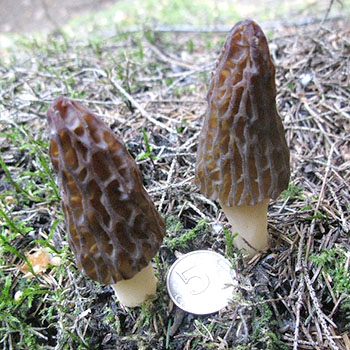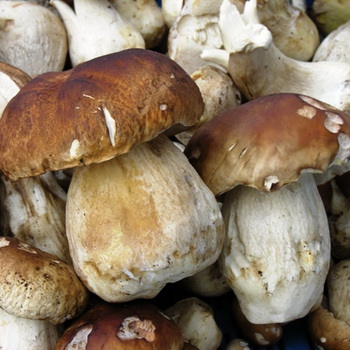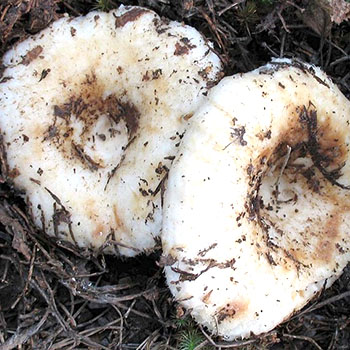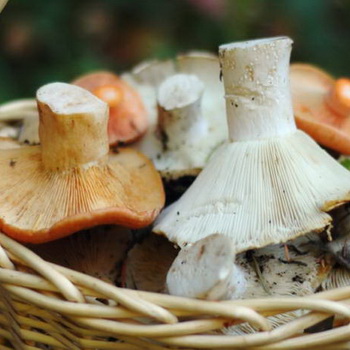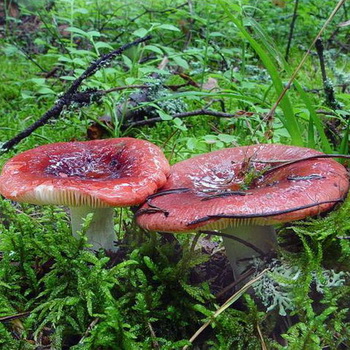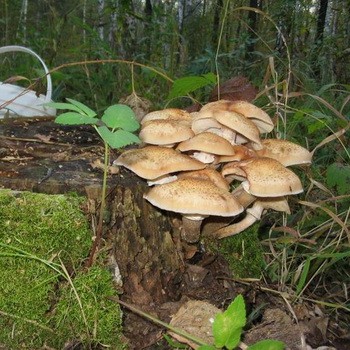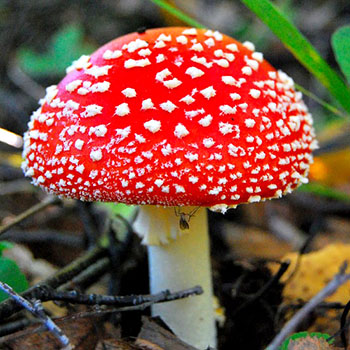October mushrooms: edible and inedible species

October landscapes impress with an unusual combination of green, yellow, orange and golden colors. In October, species of growing mushrooms are highly dependent on the weather. In mild and warm weather, porcini mushrooms can grow. In October, they are especially bright. In the case of frosts, October mushrooms may become discolored, discolored or their bright colors fade. This is especially true for rows.
So, the answer to the question whether there are mushrooms in the forest in October, you received. And what kind of species can be collected during this period and how do they look?
Edible Mushrooms That Grow In October
Fragrant hygrophor (Hygrophorus agathosmus).
Habitats: damp and mossy places in coniferous forests, grow in groups.
Season: June - October.
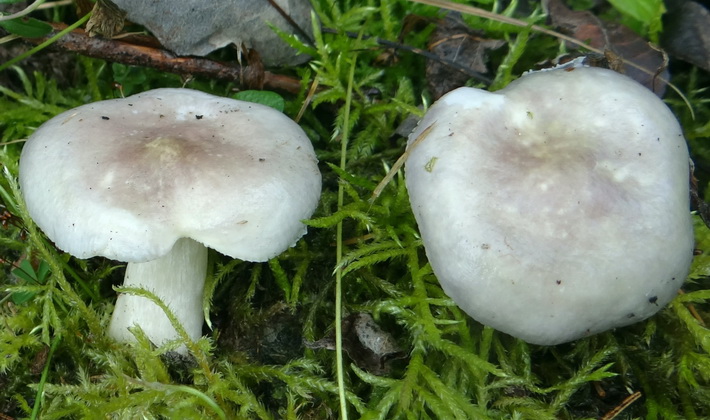
The hat has a diameter of 3-7 cm, first bell-shaped, then convex and flat. In the middle of the cap in most cases there is a flat tubercle, but there are specimens with a concave center. A distinctive feature of the species is the light gray or ashy color of a dry hat with a slightly darker shade in the center, as well as light plates that run down to the leg.
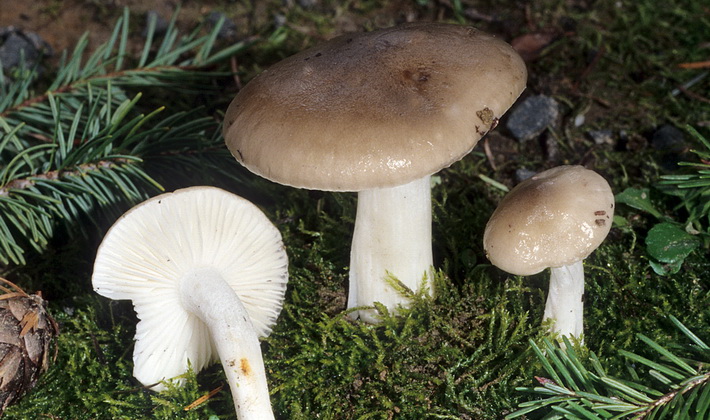
Leg long, 4-8 cm high, 3-12 mm thick, thin, smooth, whitish-gray or cream, with a powdery surface.
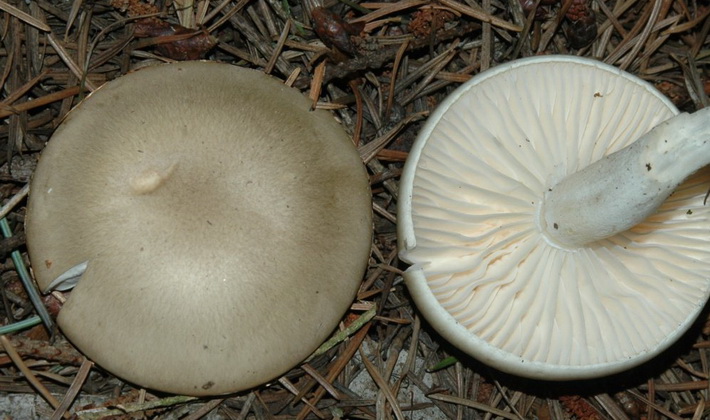
Pulp: whitish, soft, with a fragrant almond odor and sweet taste.
The plates are rare, adherent, whitish, descending down the leg.
Variability. The color of the hat varies from light gray to ash, sometimes with a beige shade, with a darker shade in the center.
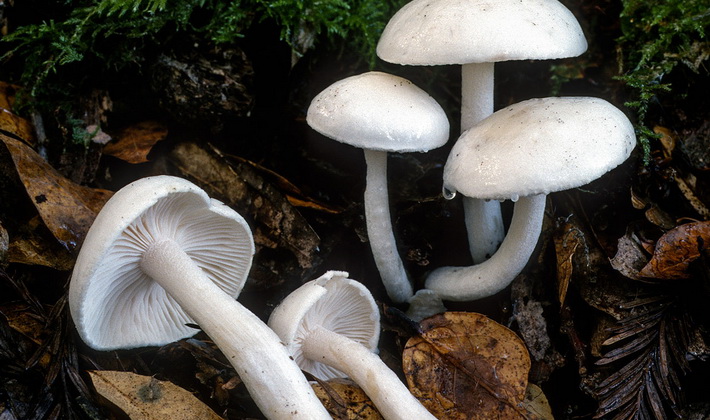
Similar views. This mushroom, growing in October, is similar in shape to a yellowish-white hygrophor (Hygrophorus eburneus), which is distinguished by the yellowish color of the hat.
Cooking Methods: fried, boiled, canned.
Edible, 4th category.
Hygrocybe red (Hygrocybe coccinea).
Small colorful mushrooms resemble circus colored caps. You can admire them, but collecting them is not recommended.
Habitats: grass and moss in mixed and coniferous forests, grow either in groups or singly.
Season: August - October.
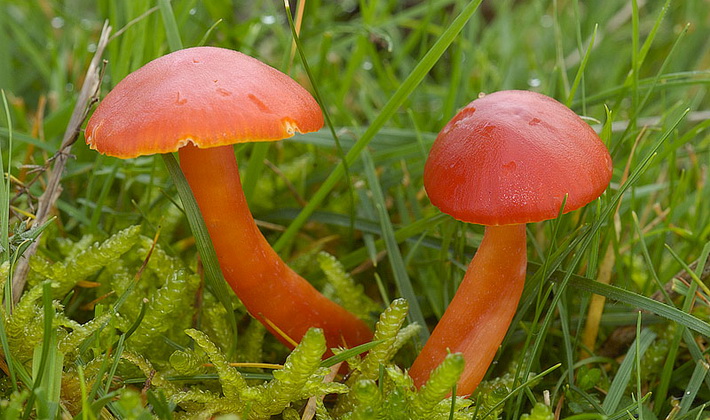
The hat has a diameter of 1-4 cm, first hemispherical, later bell-shaped and convex. A distinctive feature of the species is a grainy bright red or raspberry hat with yellow-orange zones.
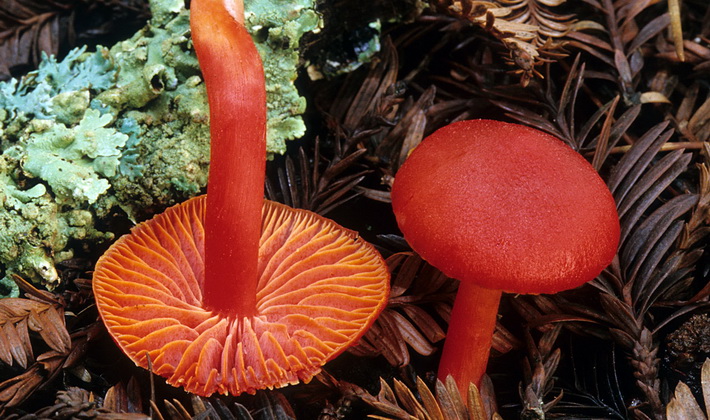
Leg 2-8 cm tall, 3-9 mm thick. The upper part of the leg is reddish, the lower part is yellowish or yellow-orange.
Medium-frequency records, first cream, later yellow-orange or light red.
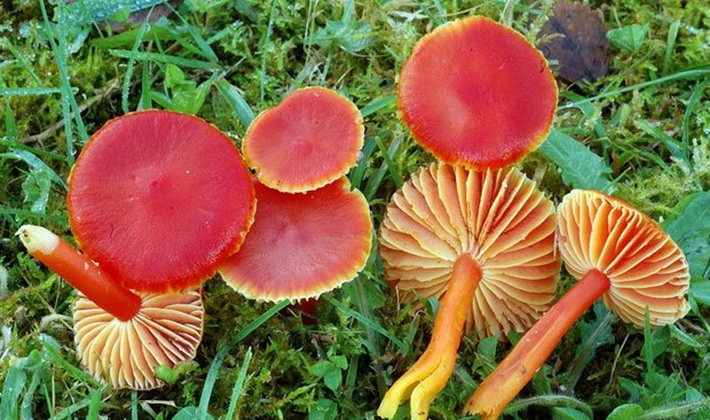
The pulp is fibrous, first creamy, later light yellow, brittle, odorless.
Variability. The color of the hat varies from bright red to raspberry with yellow spots.
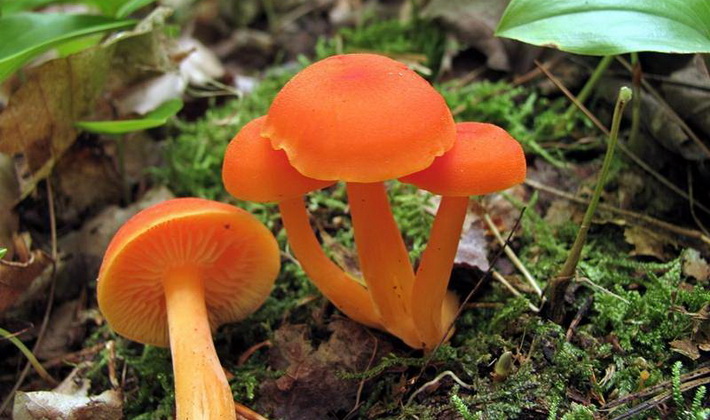
Similar views. The hygrocybe is beautiful in color similar to the cinnabar-red hygrocybe (Hygrocybe miniata), which differs not in a granular, but in a smooth-fiber hat.
Conditionally edible.
Curved Talker (Clitocybe geotropa).
Bent talkers are one of the few edible types of talkers. The authors tried dishes from them. They are juicy and delicious. However, we do not recommend picking these mushrooms due to the large number of similar inedible hallucinogenic species. They grow on the edges of the forest with thick forest litter.
Habitats: mixed and coniferous forests, at the edges, in moss, in shrubs, grow in groups or singly.
Season: July - October.
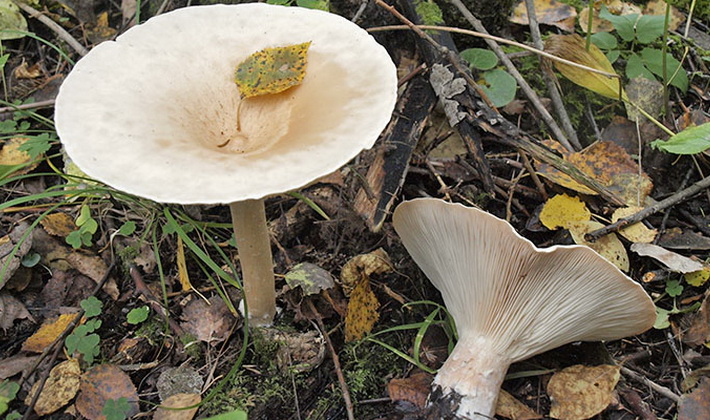
The hat is 8-10 cm in diameter, sometimes up to 12 cm, first convex with a small flat tubercle, later depressed funnel-shaped, in young specimens with a small tubercle in the middle. A distinctive feature of the species is the conical-funnel-shaped shape of the hat with an openwork top, which sometimes shines through in the sun, and with thin wavy, wrapped edges; the color of the hat is brownish, and in the center it is light brown, and on the edges it can be dark brown.
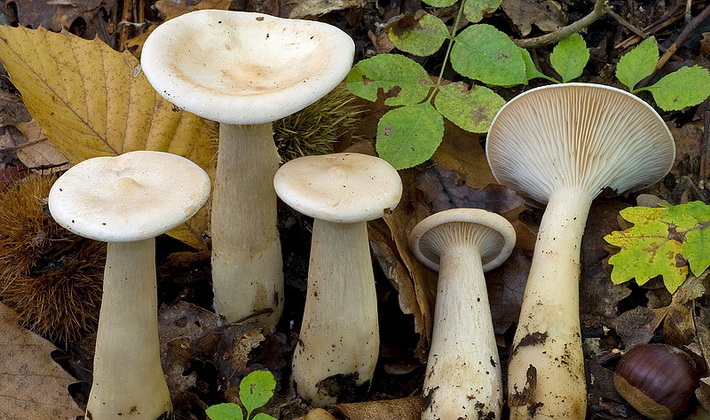
Leg 5-10 cm tall, sometimes up to 15 cm, 8-20 mm thick, the same color with a hat or lighter, cylindrical, slightly expanded at the base, fibrous, white pubescent at the bottom, brownish at the base. The length of the leg is greater than the diameter of the cap.
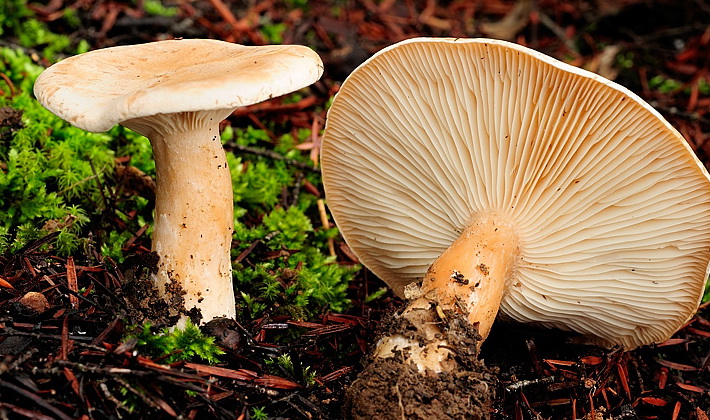
The pulp is thick, dense, white, later brown, has a pungent odor.
The plates are frequent, descending along the leg, soft, first white, later cream or yellowish.
Variability: the color of the hat is brownish, with age it can fade to fawn, sometimes with reddish spots.
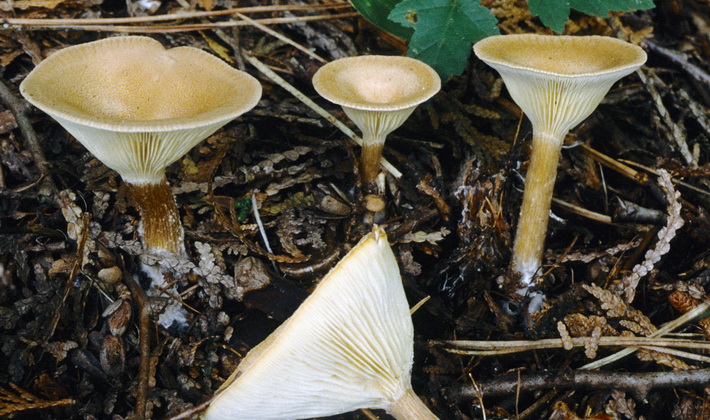
Similar edible species. The talker bent in shape, size and color is similar to funnel govorushka (Clitocybe gibba), but differs in the presence of another, fruity smell, and the brownish hat has a pinkish tint.
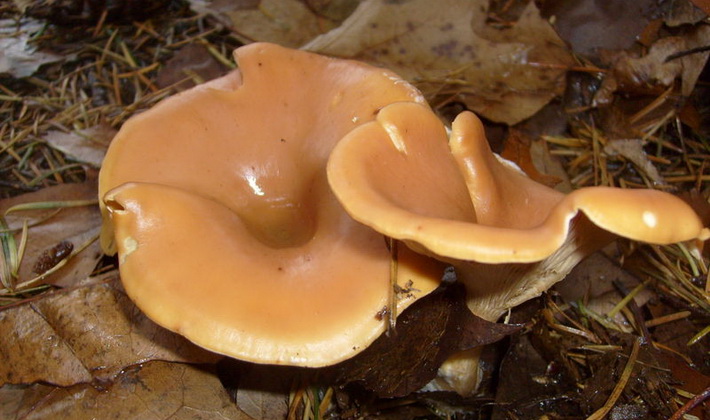
Similar poisonous species. The color of the bent-up talker is similar to the poisonous inverted talker (Clitocybe inverse), which also has hanging edges, but no funnel-shaped recess in the hat.
Cooking Methods: the mushrooms are tasty and fragrant in taste, they are fried, boiled, marinated, with preliminary boiling for about 20 minutes, but there are similar poisonous species.
Edible, 3rd (young) and 4th category.
White-cinnamon tuberous, or bulbous (Leucocortinarius bulbiger).
White spiderwebs differ from all other spider webs with an unusually beautiful appearance. They look like the fabulous Santas on one leg. White spots on a pink hat adorn their appearance. Small groups of these mushrooms can be found on the fringes of spruce and mixed forests.
Habitats: pine and mixed with birch forests, on forest litter, grow in groups or singly. A rare species, listed in the regional Red Books, status - 3R.
Season: August - October.
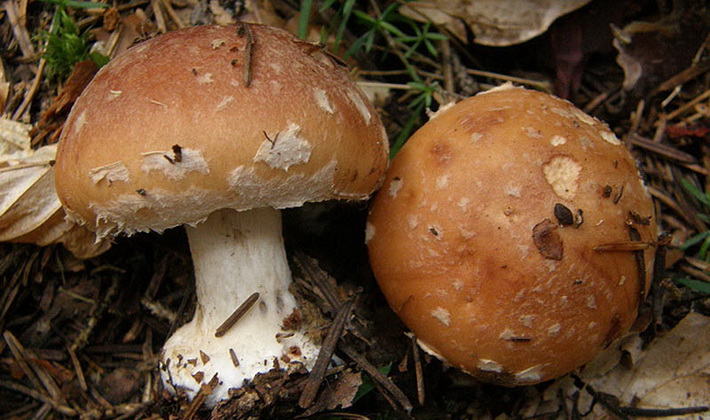
The hat has a diameter of 3-10 cm, first hemispherical, later convex-spread. A distinctive feature of the species is the unusual color of the hat: yellowish or pinkish-yellowish with white or cream spots that look like smears of paint, as well as a light leg with whitish uneven remains of the bedspread.
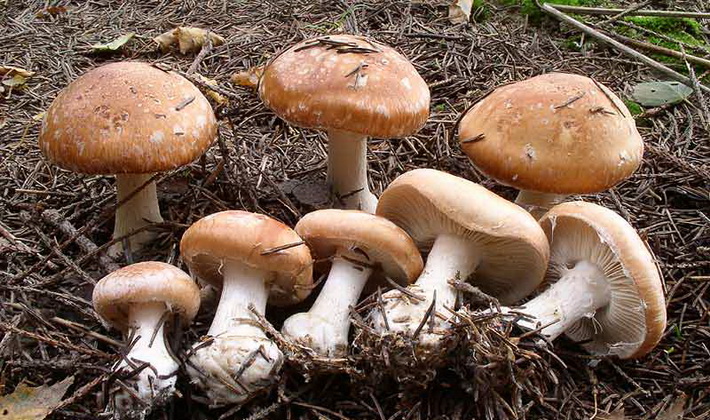
The leg has a height of 3-12 cm, 6-15 mm thick, dense, even, tuberous, whitish or brownish, with flocculent fibers on the surface.
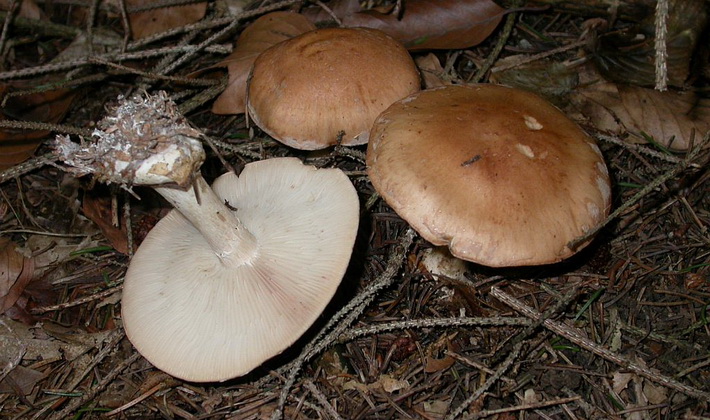
The pulp is white, under the skin of the hat is reddish, without much taste, with a mushroom smell.
The plates are wide, rare, first grown and white, later notched-fixed and cream.
Variability. The color of the hat varies from pinkish yellow to pinkish beige.
Similar views. The tuberous white spiderweed is so characteristic and individual in the color of the hat that it does not have similar species and can easily be determined.
Cooking Methods: cooking, frying, salting, after preliminary boiling.
Edible, 4th category.
Ring-shaped cap (Rozites caperatus).
Caps are ringed, these beauties with a delicate golden yellowish tint and a large ring on the leg are collected only by the elite. This is no coincidence, since they look like grebes and fly agarics.For an experienced mushroom picker, just look at the back of the hat, see the plates of the same color as the hat to distinguish them from poisonous species. Caps are ringed - tasty, slightly sweet mushrooms. You can find them near the Christmas trees in a mixed forest, in bright places, on moist soils.
Habitats: deciduous and mixed forests, grow in small groups.
Season: September October.
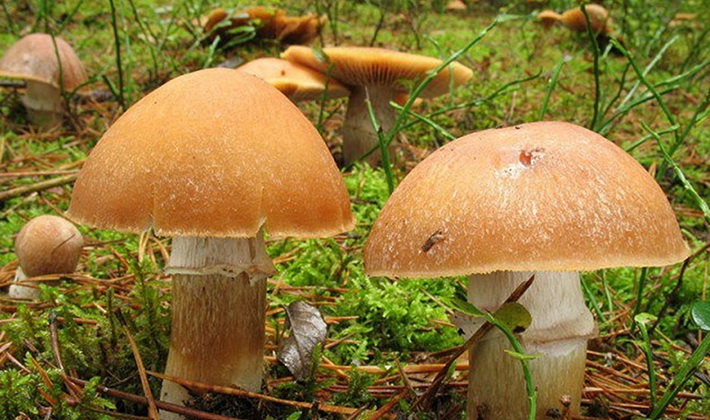
The hat has a diameter of 5-12 cm, first hemispherical, later convex-spread. A distinctive feature of the species is a furrowed or wrinkled yellow-brown hat with an umbrella-shaped shape with a tubercle in the form of a button in the middle, as well as a filmy light ring on the leg. The color of the hat in the middle is darker, and the edges are lighter. Young mushrooms have a light membranous cover at the bottom of the cap.
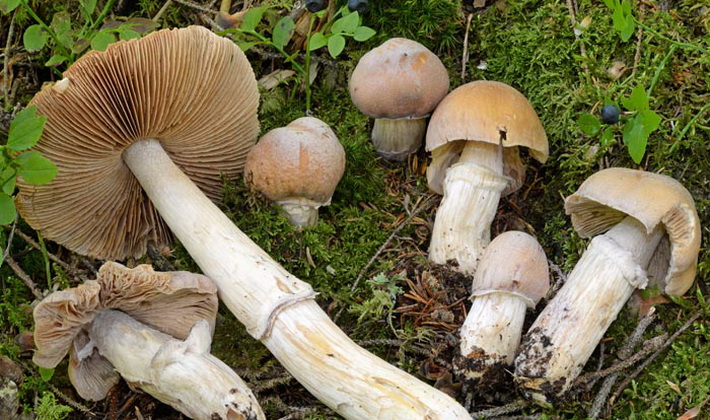
Leg 5-15 cm tall, 8-20 mm thick, smooth, even, in color of a hat or yellowish. At the top of the leg there is a wide cream or whitish membranous ring.
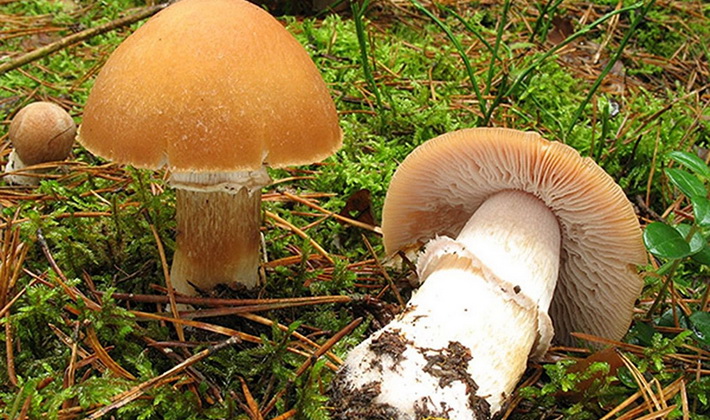
The pulp is light, fleshy, dense, fibrous.
The plates are grown, rare, yellowish in color.
Variability. The color of the hat varies from straw yellow to tan and mauve.
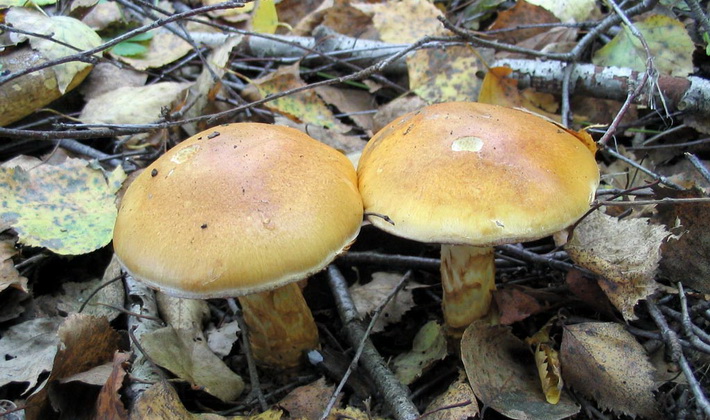
Similar views. The cap is ringed in color and shape similar to a yellow, or triumphal, cobweb (Cortinarius triumphans), which is distinguished by the absence of a tubercle on the cap and the presence of not one ring, but several traces of the remains of the bedspread.
Cooking Methods. Tasty mushrooms, soups are made of them, fried, canned.
Edible, 3rd and 4th categories.
Panellus late (Panellus serotinus).
Among the October mushrooms late panelluses are distinguished. They are not afraid of small frosts and grow until winter. Most often you can see them on stumps and fallen half-rotten trunks with moss.
Season: September - December.
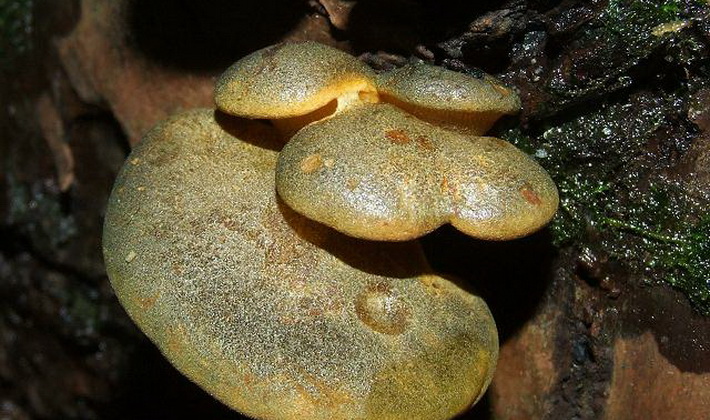
The hat has an overall size of 1-10 cm, sometimes up to 15 cm. A distinctive feature of the species is a velvety, oily oyster or ear-shaped fruit body in wet weather with a lateral pedicle, first greenish brown in color, later olive yellow.
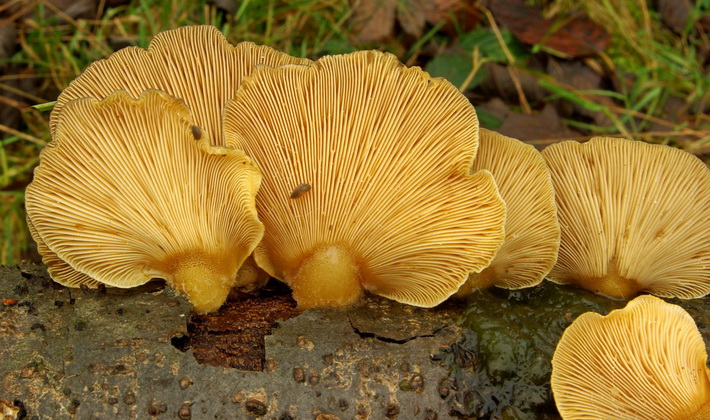
Leg eccentric, short, 0.5-2 cm, buffy yellow with dark scales.
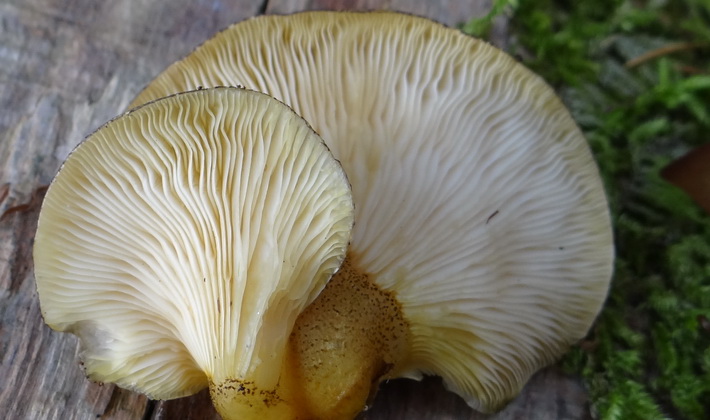
The flesh inside the cap is initially white-creamy, and closer to the plates and surface it is grayish-cream, gelatinized, with a faint, delicate mushroom smell.
The plates are very frequent and thin, dropping to the leg, first white and light straw, later light brown and brown.
Variability. The color of the hat varies greatly, first greenish-brown, later olive-yellow, gray-green and, finally, lilac.
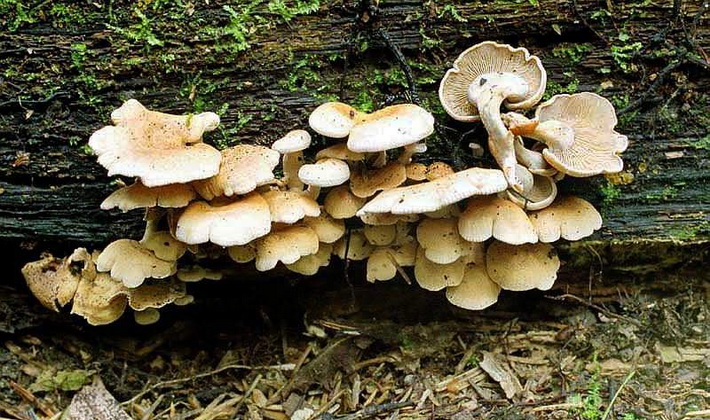
Similar views. Edible Panellus late in shape similar to inedible astringent panellus (Panellus stypticus), which is distinguished by a strongly astringent taste and tan hats.
Edibility: tasty, soft, tender, fatty mushrooms, they can be fried, boiled soups, canned.
Edible, 3rd category (early) and 4th category.
Other edible mushrooms growing in October
The following mushrooms are also harvested in the forests of the Moscow Region in October:
- Autumn honey mushrooms
- Ryadovki
- Yellow blackberries
- Raincoats
- Cobwebs
- Black and aspen breasts
- Yellow skin champignons
- Uneven and neutral milkers
- Flywheels
- Common chanterelles
- Food and Yellow Russula
- Yellow-brown and ordinary boletus.
Inedible October Mushrooms
Psatyrella velvety (Psathyrella velutina).
Small psatirella mushrooms grow in large groups and are often invisible in the autumn forest, covered with fallen leaves. All of them are inedible. They grow at the foot of hemp and trees.
Habitats: dead wood and stumps of deciduous trees grow in clusters.
Season: August - October.
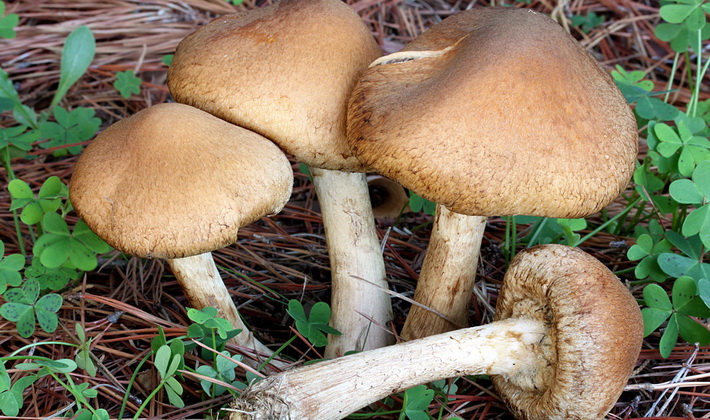
The hat has a diameter of 4-10 cm, first hemispherical, later convex-spread. A distinctive feature of the species is ocherous, tan, pink-ocher, felt-scaly hat with a tubercle, darker - brown in the middle and fibrous pubescence along the edge.
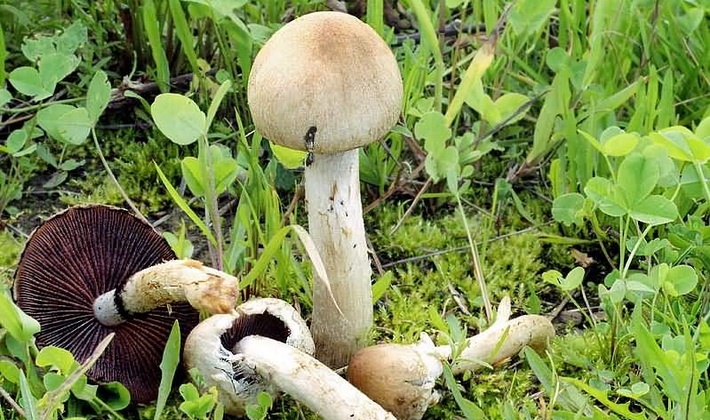
The leg is smooth, white, fibrous-scaly, hollow, with a ring or a trace of the ring.
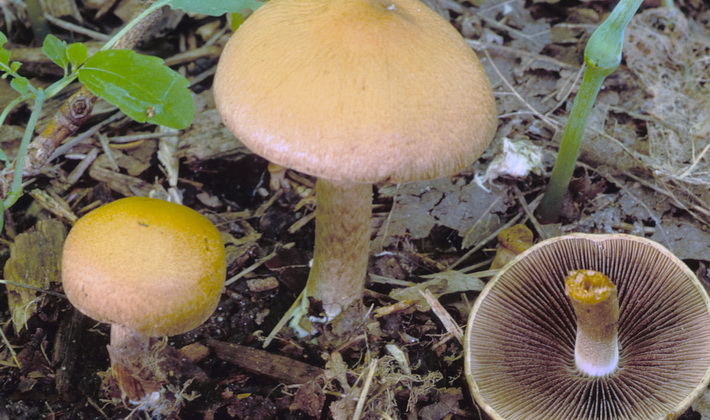
The flesh is faded brown, thin, crumbly, with a spicy smell.
The plates are frequent, brownish in their youth, later almost black with a brown tint and with light droplets of liquid, curved, notched-grown.
Variability. The color of the hat can vary from reddish to buffy.
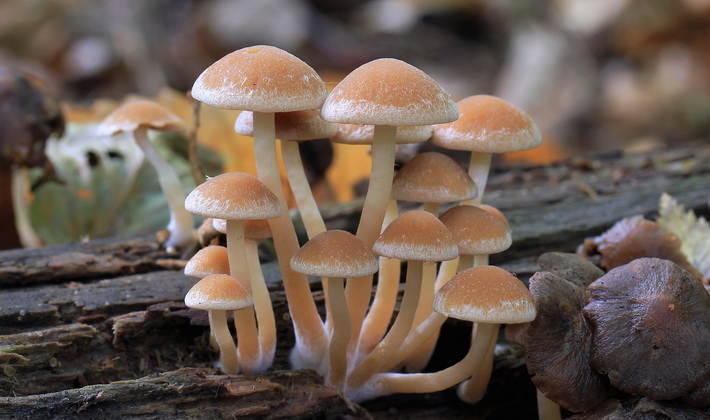
Similar views. Psatirella is velvety in shape similar to spherical psatirella (Psathyrella piluliformis), which has a dark gray-brown hat and does not have a fringed bedspread along the edge.
Inedible.
Psatirella dwarf (Psathyrella pygmaea).
Habitats: deciduous and mixed forests, on decayed hardwood, grows in large groups.
Season: June - October.
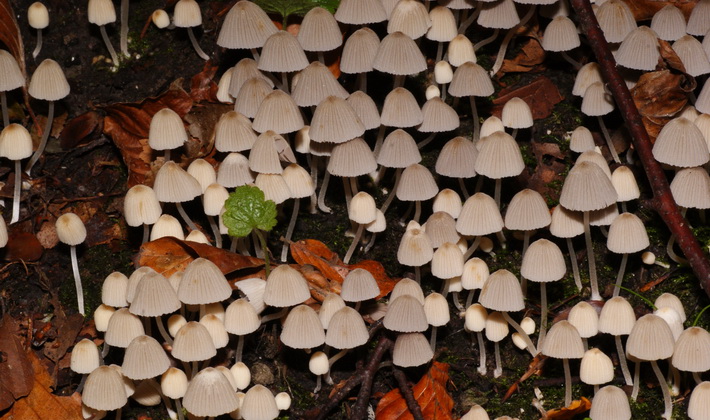
The hat has a diameter of 5-20 mm, first bell-shaped, then convex. A distinctive feature of the species is a pale beige or light brown hat with a blunt tubercle and with a ribbed, lighter and whitish edge. The surface of the cap is smooth, matte.
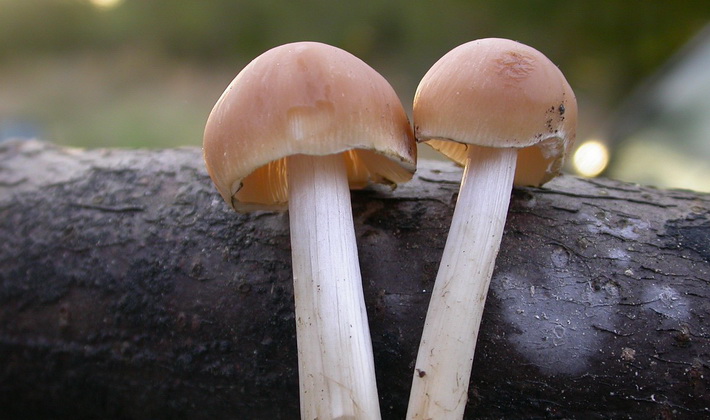
The leg has a height of 1-3 cm and a thickness of 1-3 mm, cylindrical, often curved-flattened, hollow inside, with a powdery coating, white-cream or cream, pubescent at the base.
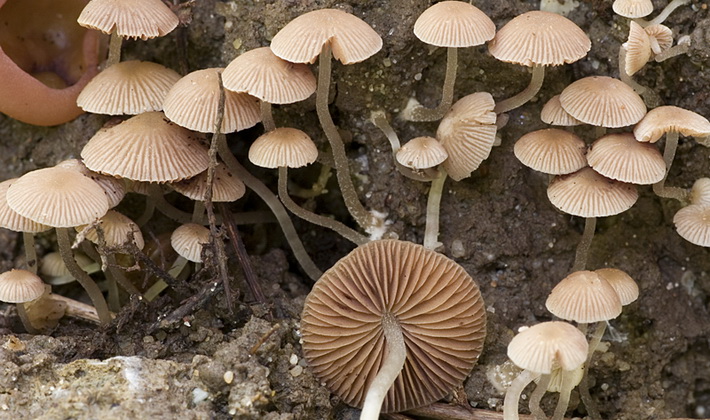
The flesh is brittle, whitish, without a characteristic odor and taste.
The plates are frequent, adherent, first whitish, later cream or beige, lighter to the edge of the cap, later brownish brown.
Variability. The color of the hat can vary significantly from pale beige to light brown and light straw to reddish brown and ocher brown.
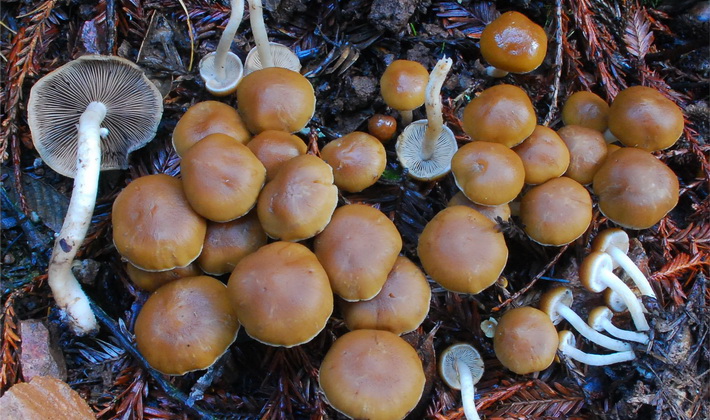
Similar views. Psatirella dwarf similar in size to a small spherical psatirella (Psathyrella piluliformis), which is distinguished by a convex and round shape of a hat and a white, smooth leg, hollow inside.
Inedible.
Mycena tilted (Mycena inclinata).
Mycenae growing on stumps in October can occupy large areas until the first frost, after which they become translucent and discolored.
Habitats: stumps and rotting trunks in mixed and deciduous forests, grow in large groups.
Season: July - November.
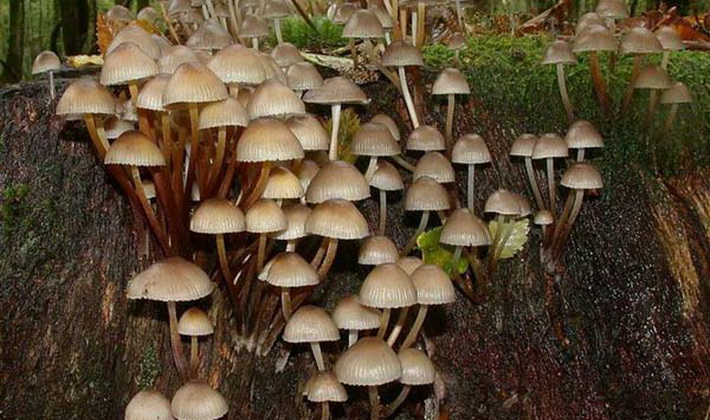
The hat has a diameter of 1-2.5 cm, fragile, first bell-shaped with a sharp crown, later an egg-shaped or bell-shaped with a round crown. A distinctive feature of the species is a light-nut or cream-colored hat with a small brownish tubercle. The surface of the cap is covered with thin radial grooves, and the edges are uneven and are often even serrated.
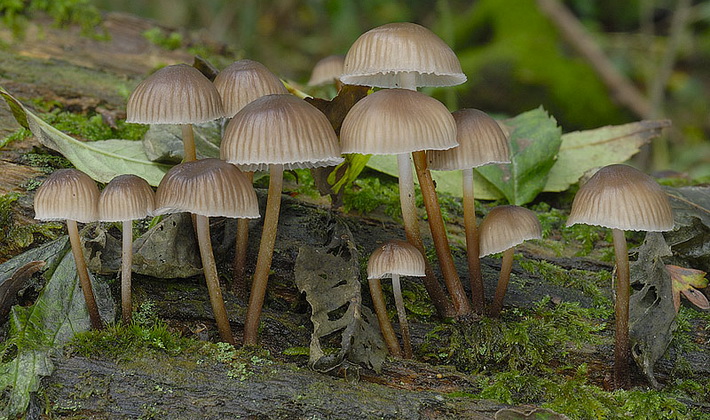
The leg is long and thin, 3-8 cm high, 1-2 mm thick, cylindrical, smooth in the upper part, and powdery coating on the bottom. The legs are homogeneous in color: first cream, later light brown and brown.
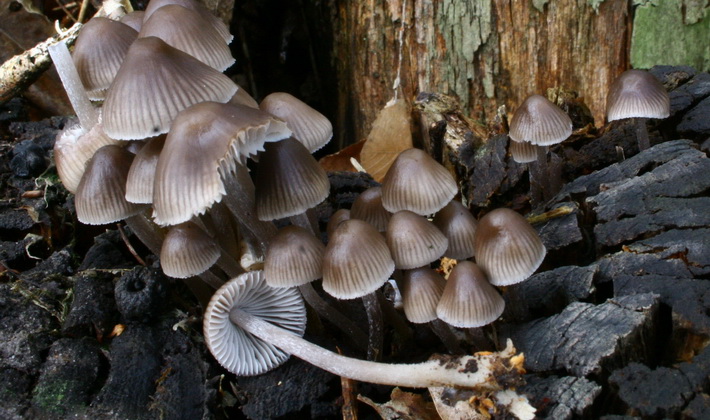
The flesh is thin, white, has a strong smell of musty, and the taste is rancid and pungent.
The plates are rare and not wide, whitish or cream. With age, the plates at the ends of the hats acquire a brownish tint.
Variability: the color of the hat varies from light nut and cream to yellowish. The leg is light at first. The plates are initially whitish or cream, later they become pinkish-lilac or yellowish.
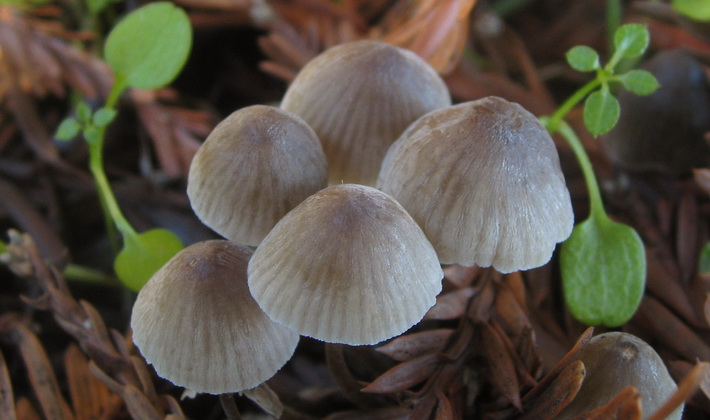
Similar views. Mycenae inclined in shape and color are similar to thin cap mycenae (Mycena leptocephala)which differ in the flesh smell of chlorinated water.
Inedible because the musty smell does not soften even with prolonged boiling.
Mycena ashen (Mycena cinerella).
Habitats: stumps and rotting trunks in mixed and deciduous forests, grow in large groups.
Season: July - November.
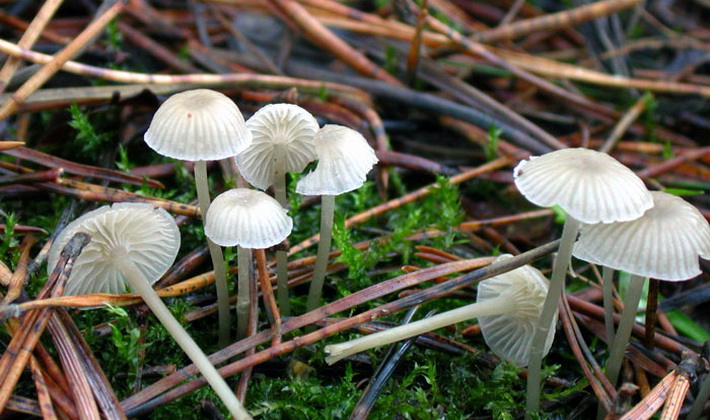
The hat has a diameter of 1-3 cm, fragile, first bell-shaped with a sharp crown, later an egg-shaped or bell-shaped with a round crown. In young specimens, the edge of the cap with denticles, in mature mushrooms, is smooth. A distinctive feature of the species is a whitish bell-shaped hat shape with a top that has a darker shade. The surface of the cap has radial grooves at the locations below the plates.
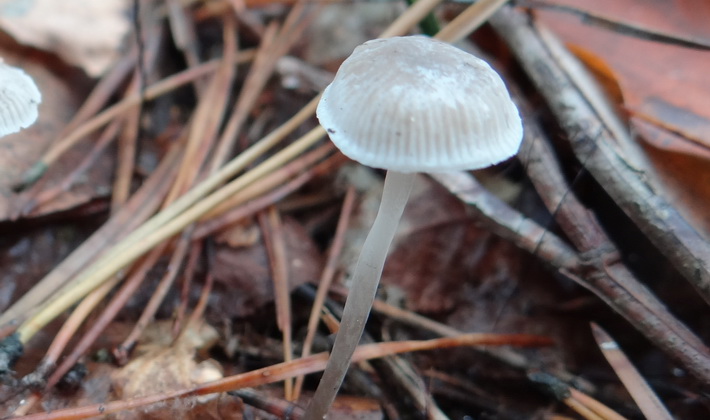
The leg is long and thin, 3-8 cm high, 1-3 mm thick, cylindrical, smooth in the upper part, and powdery coating on the bottom.In young specimens, the leg is light, homogeneous, whitish, in mature specimens, the lower part of the leg has a brownish tint. The leg is hollow inside.
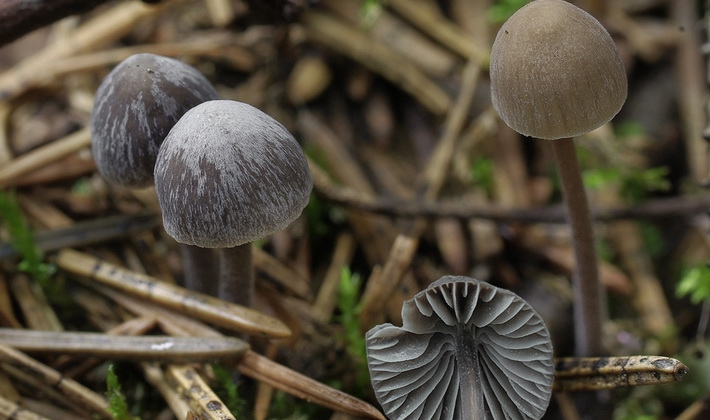
The pulp is thin, whitish, without a special smell.
The plates are rare and not wide, whitish or cream. With age, the plates at the ends of the hats acquire a brownish tint.
Variability: the color of the hat varies from whitish to ashen, cream, creamy yellow.
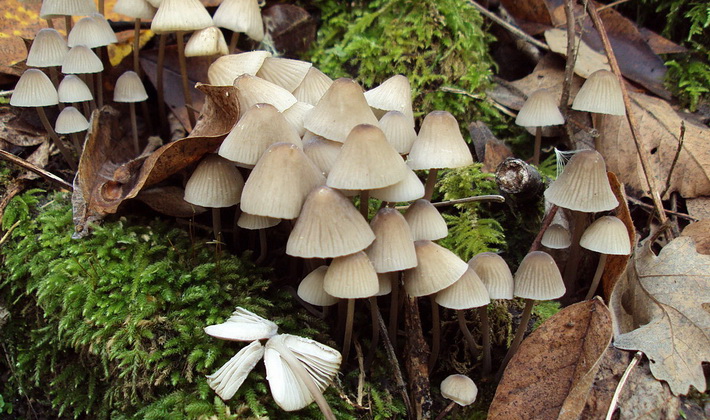
Similar views. The ashen mycena is similar in shape and color to the milk mycena (Mycena galopus), which has a darker brownish leg.
Inedible because they are tasteless.
Collybia brownish (Collybia tenacella).
Habitats: coniferous forests, on forest litter, next to cones, grow in groups.
Season: August - October.
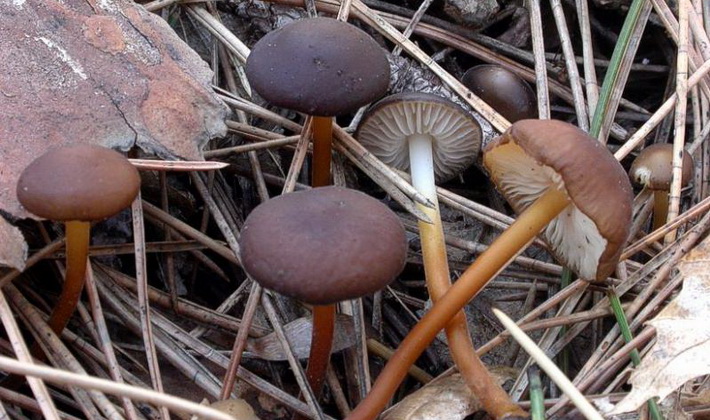
The hat has a diameter of 1-3 cm, first convex, later flat. A distinctive feature of the species is an almost flat, thin and fragile brownish hat with a small depression in the center and around it with a small roller of a darker shade. Deepening may not be, but only a small tubercle.
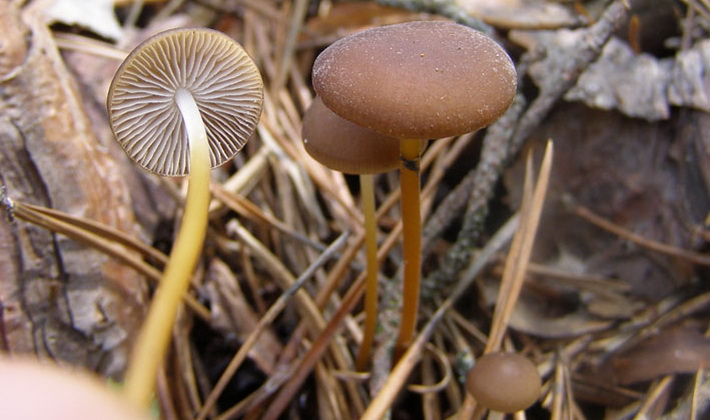
The leg is thin and long, 2-8 cm high and 2-5 mm thick, smooth, cylindrical in the same color as the hat, or slightly lighter. The base of the leg ends with a long root appendage with a velvety surface.
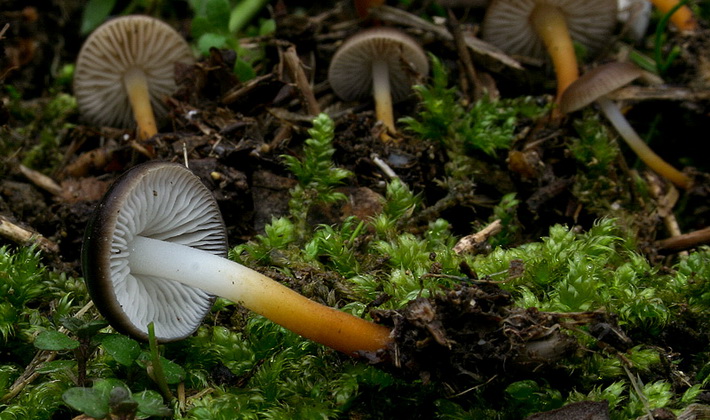
The pulp is thin, odorless, bitter in taste.
The plates are initially whitish and cream, frequent and thin, adhered to the peduncle, later yellowish.
Variability: the color of the hat varies from light brown and hazel to dark brown.
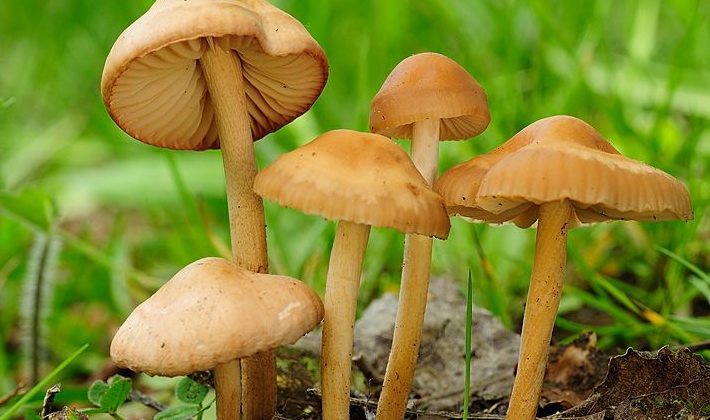
Similar views. The brown collibia can be confused with the edible meadow loaf (Marasmius oreades), which is similar in color and size, but differs in a bell-shaped hat with a central bulge, in addition, it smells of hay.
Inedible due to the bitter taste, which is not completely eliminated even with prolonged cooking.
Cucumber macrocystidia (Macrocystidia cucumis).
A small fungus macrocystidium resembles a small collibia or a round mycene in shape. These colorfully painted mushrooms can often be found on stumps in September.
Habitats: near gardens, pastures, in gardens and parks, on manicured lands, grow in groups.
Season: July - October.
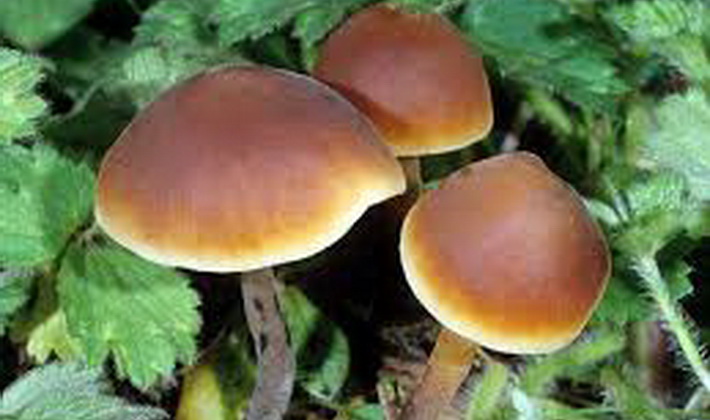
The hat has a size of 3 to 5 cm, first hemispherical, then convex or bell-shaped and then flat. A distinctive feature of the species is a brown-red or brown-brown velvet hat with a tubercle and light yellow edges.
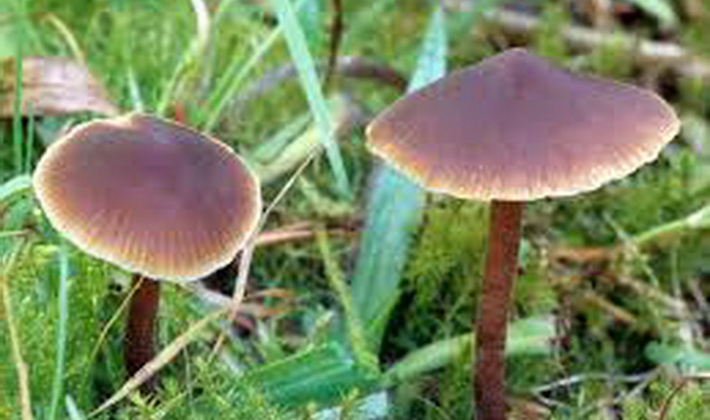
The leg has a height of 3-7 cm, a thickness of 2-4 mm, velvety, light brown on top, dark brown or black-brown underneath.

The pulp is dense, whitish-cream, with a slight odor.
Medium-frequency plates, notch-attached, first light cream, later cream and brownish.
Inedible.
Shod collibia (Collybia peronatus).
Colibians grow mainly on tree roots and on forest litter. October collibia are among the fallen leaves and are weakly visible.
Habitats: mixed and coniferous forests, on forest litter, in moss, on decaying wood, stumps and roots, grow in groups.
Season: June - October.
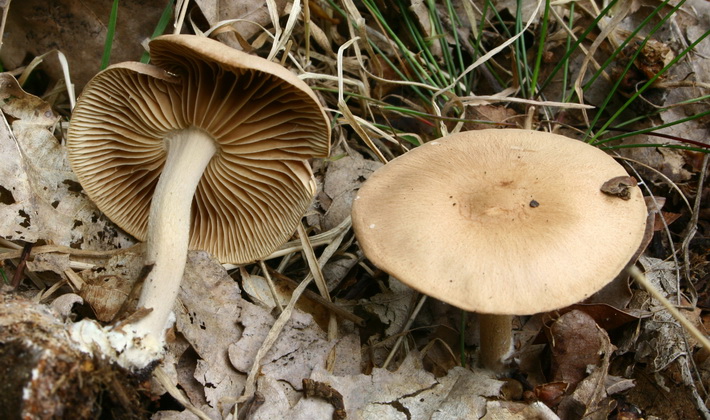
The hat has a diameter of 3-6 cm, first hemispherical or convex with a curved edge, then convex-prostrate with a small flat tubercle, in dry weather, matte. The first distinctive feature of the species is the creamy pink color of the hat with a darker pinkish-red zone in the middle and with a brownish edge with small fringes or cloves.
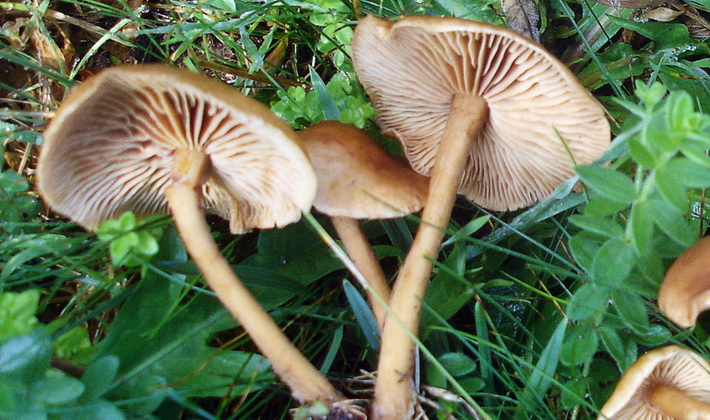
Leg 3-7 cm high, 3-6 mm thick, cylindrical, expanded near the base, inside hollow, the same color with a hat or lighter, with felt plaque. The second distinctive feature of the species is the special structure of the legs. It contains two parts - the upper hollow is light brown and the lower is wider and dark brown, which represents shoes for the legs. These parts can be separated by a thin light stripe, but it may not be.
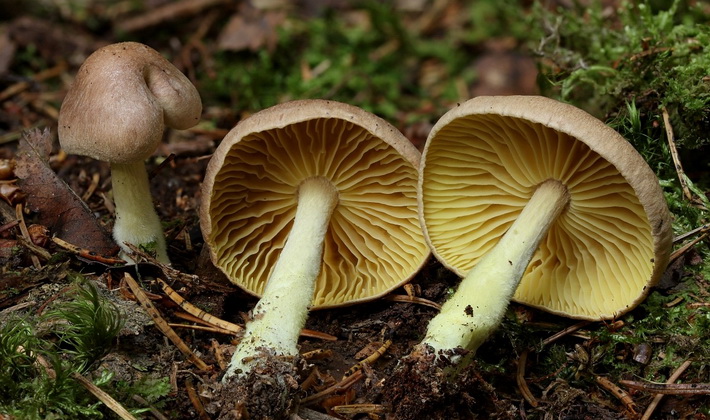
The pulp is thin, dense, yellowish, without a special smell, but with a burning taste.
Medium-frequency plates, slightly grown or loose, narrow, frequent, then reddish, pink-brown, yellow-brown with a lilac hue.
Variability: the color of the hat is variable depending on the maturity of the fungus, the month and the humidity of the season - gray-brown, pinkish-brown, pinkish-red with a darker, usually brownish middle. The edges may be slightly lighter and have a shallow fringe, but may be of a different, pinkish-brownish color and also with a fringe that resembles denticles.
Similar views. The view is very characteristic and easily distinguishable from others.
Inedible due to caustic and burning taste.
